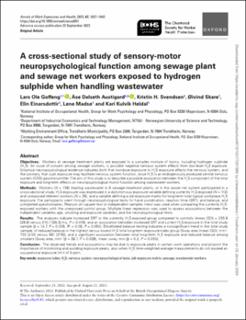| dc.description.abstract | Objectives Workers at sewage treatment plants are exposed to a complex mixture of toxins, including hydrogen sulphide (H2S). An issue of concern among sewage workers, is possible negative nervous system effects from low-level H2S exposure. Empirical neuropsychological evidence indicates both that low-dose exposure to H2S exposure affects the nervous system, and the contrary, that such exposure may facilitate nervous system function, since H2S is an endogenously produced central nervous system (CNS) gasotransmitter. The aim of this study is to describe a possible association between the H2S component of the total exposure and long-term effects on neuropsychological motor function among wastewater workers. Methods Workers (N = 138) treating wastewater in 6 sewage-treatment plants, or in the sewer net system participated in a cross-sectional study. H2S exposure was expressed in a dichotomous exposure variable defining currently H2S-exposed (N = 112) and unexposed referent workers (N = 26), and a variable defining a job-exposure matrix for long-term total typical workplace H2S exposure. The participants went through neuropsychological tests for hand coordination, reaction time (SRT), and balance, and completed questionnaires. Pearson chi-square test or independent samples t-test was used when comparing the currently H2S-exposed workers with the unexposed control group. Multiple linear regression was used to assess associations between the independent variables age, smoking and exposure variables, and the neuropsychological tests. Results The analyses indicate increased SRT in the currently H2S-exposed group compared to controls (mean [SD] = 225.8 [29.9] versus 210.7 [26.3] ms, P = 0.019), and an association between increased SRT and current H2S-exposure in the total study sample (β = 14.7, P = 0.026, R2 = 0.06, P = 0.050). Blindfolded balance testing indicates a nonsignificant trend in the total study sample, of reduced balance in the highest versus lowest H2S total long-term exposure-index group (Sway area [mean {SD}, mm2: 702 [410] versus 581 [278]), and a significant association between total long-term H2S exposure and reduced balance among smokers (Sway area, mm2 [β = 38.7, P = 0.039], mean sway, mm [β = 0.3, P = 0.015]). Conclusion The observed trends and associations may be due to exposure peaks in certain work operations and pinpoint the importance of minimizing and avoiding exposure peaks, also when H2S time-weighted average measurements do not exceed an occupational exposure limit of 5 ppm. | |
